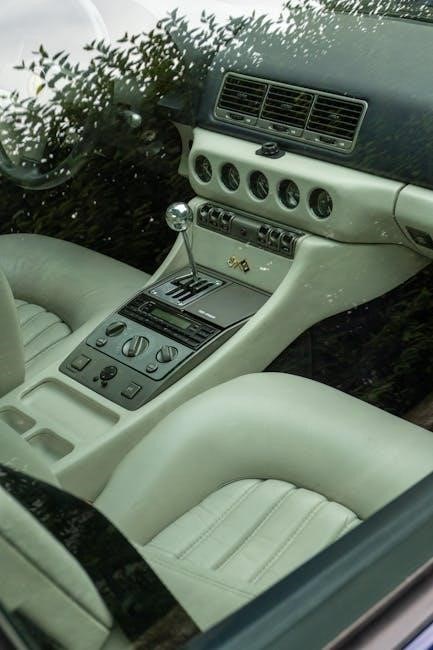what is 6 speed manual
A 6-speed manual transmission is a type of gearbox that allows drivers to manually select one of six forward gear ratios. It is widely used in vehicles to enhance performance, fuel efficiency, and driver control. This system requires the use of a clutch pedal and a gearshift to operate. The 6-speed manual transmission has become popular among driving enthusiasts due to its ability to deliver improved acceleration and better fuel economy compared to traditional automatic transmissions. Understanding its mechanics and benefits is essential for car enthusiasts and professionals alike.

1.1 What is a 6-Speed Manual Transmission?

A 6-speed manual transmission is a type of automotive gearbox that allows a vehicle to operate with six distinct forward gear ratios and one reverse gear ratio. It is a mechanical system that requires the driver to manually select the appropriate gear using a gearshift and clutch pedal. The transmission is designed to optimize engine performance, fuel efficiency, and driving control by providing a wide range of gear options for various driving conditions.
The 6-speed manual transmission consists of a gearset, clutch mechanism, and gearshift assembly. The gearset includes six forward gears and one reverse gear, each designed to provide optimal torque and speed for specific driving scenarios. The clutch pedal disengages the engine from the transmission, allowing the driver to shift gears smoothly without grinding or damaging the gears. The gearshift, typically located on the center console or steering column, is used to manually select the desired gear ratio.

The primary purpose of a 6-speed manual transmission is to give the driver precise control over the vehicle’s power delivery. By manually shifting gears, the driver can optimize engine RPM for acceleration, fuel efficiency, or climbing steep inclines. This level of control is particularly beneficial for drivers who enjoy spirited or performance-oriented driving. Additionally, the 6-speed manual transmission is often lighter and more cost-effective than automatic or dual-clutch transmissions, making it a popular choice for both economy and sports vehicles.
1.2 Importance of Understanding Manual Transmissions
Understanding manual transmissions, particularly the 6-speed manual, is crucial for drivers who want to maximize their vehicle’s performance, efficiency, and longevity. A manual transmission requires active engagement from the driver, which fosters a deeper connection between the driver and the vehicle. By comprehending how the transmission operates, drivers can optimize gear shifting techniques to enhance fuel economy, reduce wear and tear on components, and improve overall driving experience.
One of the key reasons to understand manual transmissions is to achieve better control over the vehicle. Manual transmissions allow drivers to select the most appropriate gear for specific driving conditions, such as climbing hills, merging onto highways, or navigating city traffic. This level of control is particularly beneficial for drivers who frequently encounter varying terrain or those who prioritize performance driving. Additionally, understanding how to use the clutch and gearshift effectively can prevent premature wear on the transmission and clutch assembly, potentially saving money on repairs over time.

Another important aspect is fuel efficiency. Modern 6-speed manual transmissions are designed to optimize engine performance at different speeds. By shifting gears at the correct RPM, drivers can reduce fuel consumption, especially during long drives or in stop-and-go traffic. This not only saves money on gasoline but also contributes to a more environmentally friendly driving experience.
Furthermore, understanding manual transmissions is essential for maintaining the vehicle’s health. Proper shifting techniques can extend the lifespan of the transmission and clutch. Drivers who are knowledgeable about manual transmissions are also better equipped to diagnose and address issues early, preventing minor problems from escalating into costly repairs.

History and Evolution of Manual Transmissions
The history of manual transmissions dates back to the early 20th century, with the first manual gearboxes offering only a few gears. Over time, advancements in engineering led to the development of more sophisticated systems. The 6-speed manual transmission emerged as a refinement, combining improved performance with better fuel efficiency. Its evolution reflects the automotive industry’s focus on enhancing driver control, reducing wear, and optimizing power delivery. This progression has made the 6-speed manual a staple in modern vehicles.
2.1 The Development of Manual Transmissions
The development of manual transmissions began in the early 20th century, with the first manual gearboxes offering only two or three gears; These early systems were rudimentary, requiring drivers to manually engage gears using a clutch pedal and a gearshift. Over time, engineers recognized the need for more gears to improve performance, fuel efficiency, and driver control. By the mid-20th century, four-speed manual transmissions became standard, offering better acceleration and reduced wear on engines.
The introduction of five-speed manual transmissions in the 1960s marked a significant milestone. This added an extra gear for higher speeds, reducing engine strain at highway velocities; The 1980s saw the widespread adoption of six-speed manual transmissions, particularly in high-performance vehicles. This development allowed for even greater precision in gear ratios, enabling smoother acceleration and improved fuel economy.
Modern six-speed manual transmissions incorporate advanced materials and technologies, such as lightweight components and synchronized gears, to enhance durability and ease of use. The development of manual transmissions has been driven by the need for better performance, efficiency, and driver engagement. Today, the six-speed manual remains a popular choice for enthusiasts and professionals alike, offering a balance of power and precision.

2.2 The Advancements Leading to 6-Speed Manuals
The transition from earlier manual transmissions to 6-speed manuals was driven by significant technological advancements. One key development was the refinement of gear manufacturing processes, allowing for more precise and durable gear teeth. This improvement enabled smoother shifting and reduced wear over time. Additionally, the introduction of synchronizers in the mid-20th century simplified the shifting process, making manual transmissions more accessible to a broader range of drivers.
Another critical advancement was the use of lightweight materials, such as aluminum and advanced composites, which reduced the overall weight of the transmission. This not only improved fuel efficiency but also enhanced the vehicle’s power-to-weight ratio, leading to better performance. Furthermore, the integration of electronic controls and sensors allowed for more efficient gear ratio optimization, ensuring that each gear provided the best possible balance of power and fuel economy.
The development of 6-speed manual transmissions also benefited from advancements in computer-aided design (CAD) and simulation technologies. These tools enabled engineers to test and refine gear ratios and transmission layouts virtually, leading to more efficient and reliable designs. The increased number of gears allowed for a wider range of driving scenarios to be accommodated, from low-speed city driving to high-speed highway cruising.
Finally, the demand for better fuel efficiency and performance in modern vehicles accelerated the adoption of 6-speed manual transmissions. By providing more gear options, drivers could optimize engine speed for various driving conditions, resulting in improved mileage and reduced emissions. These advancements collectively paved the way for the widespread use of 6-speed manual transmissions in contemporary vehicles.

How a 6-Speed Manual Transmission Works
A 6-speed manual transmission operates by enabling the driver to manually select one of six gear ratios using a gearshift. Each gear is designed for specific driving conditions, optimizing engine power and efficiency. The transmission works in harmony with the engine, allowing the driver to control speed and torque effectively. This system provides enhanced performance and fuel efficiency compared to automatic transmissions, making it a preferred choice for driving enthusiasts seeking greater control over their vehicle.
3.1 Basic Principles of a Manual Transmission
A 6-speed manual transmission operates based on the fundamental principle of gear ratios, enabling the vehicle to optimize power delivery and fuel efficiency across various driving conditions. At its core, a manual transmission consists of a set of gears, a clutch mechanism, and a gearshift. The driver uses the clutch pedal to disconnect the engine from the transmission, allowing for smooth gear changes. Once the clutch is pressed, the gearshift is moved to select the desired gear, which corresponds to a specific gear ratio.
The transmission housing contains the gearset, which includes both input and output shafts. The input shaft is connected to the engine, while the output shaft transfers power to the driveshaft and ultimately to the wheels. Each gear ratio is designed to provide optimal performance at different speeds, with lower gears offering more torque for acceleration and higher gears allowing for better fuel efficiency at higher speeds.
The clutch mechanism plays a crucial role in the operation of a manual transmission. It consists of a clutch disc, pressure plate, and release bearing. When the clutch pedal is pressed, the release bearing disengages the clutch disc from the flywheel, interrupting power flow between the engine and transmission. This allows the driver to shift gears without grinding or damaging the gears. Releasing the clutch pedal gradually re-engages the clutch disc with the flywheel, restoring power to the transmission.
The gearshift, located on the center console, is connected to a linkage system that selects the appropriate gear within the transmission. The driver must coordinate the clutch pedal and gearshift to ensure smooth transitions between gears. Proper synchronization of these components is essential for efficient and effective operation of the manual transmission.
3.2 Gear Ratios and Their Functions
Gear ratios are a critical component of a 6-speed manual transmission, determining how power is delivered to the wheels. Each gear ratio represents the relationship between the number of teeth on the driven gear and the driving gear. This ratio directly affects the vehicle’s acceleration, fuel efficiency, and overall performance. In a 6-speed manual transmission, there are six forward gear ratios, each optimized for specific driving conditions.
The lower gears (1st and 2nd) are designed to provide high torque multiplication, which is essential for starting from a standstill, climbing steep inclines, or hauling heavy loads. These gears allow the engine to produce maximum torque at low speeds, enabling the vehicle to accelerate efficiently. As the vehicle gains speed, higher gears (3rd, 4th, 5th, and 6th) are engaged, reducing torque multiplication and allowing the engine to operate at lower RPMs. This results in improved fuel efficiency and reduced engine wear during cruising or highway driving.

The 6th gear, in particular, is often an overdrive gear, further reducing engine RPMs at high speeds. This not only enhances fuel economy but also makes driving more comfortable by minimizing engine noise and vibration. The specific gear ratios vary between vehicles, depending on the engine’s power output, torque characteristics, and the vehicle’s intended use. For example, sports cars may have closer gear ratios for quicker acceleration, while trucks or SUVs may have wider ratios for towing and hauling capabilities.
In addition to the forward gears, a reverse gear is included for backing up. This gear typically has a unique ratio to provide the necessary torque for reversing, even on inclines. The strategic arrangement of these gear ratios ensures that the engine operates within its optimal power band, delivering the right amount of power and efficiency for any driving scenario.
3.3 The Role of the Clutch Mechanism
The clutch mechanism is a vital component of a 6-speed manual transmission, enabling the driver to smoothly transition between gears. Its primary function is to temporarily disconnect the engine from the transmission, allowing the gears to change without causing damage or discomfort. When the clutch pedal is pressed, it disengages the engine’s power from the transmission, giving the driver control to shift gears manually.
The clutch system consists of several key components, including the clutch pedal, master cylinder, slave cylinder, and the clutch disc. When the driver presses the clutch pedal, it activates the master cylinder, which sends hydraulic pressure to the slave cylinder. This pressure then moves the clutch disc away from the flywheel, breaking the connection between the engine and the transmission. This disengagement allows the driver to shift gears without resistance.

Releasing the clutch pedal reverses the process, gradually reconnecting the engine to the transmission. The clutch disc re-engages with the flywheel, restoring power to the wheels. The smooth operation of the clutch is essential for seamless gear shifts, preventing jerky movements or gear grinding. Proper use of the clutch also helps maintain fuel efficiency and reduces wear on the transmission components.
The clutch mechanism is particularly important during low-speed maneuvers, such as starting from a standstill or navigating heavy traffic. It provides the necessary control to modulate power delivery, ensuring smooth acceleration. Additionally, the clutch allows drivers to “feather” or partially engage the clutch, which can be useful in situations requiring precise control, such as driving uphill or towing a trailer.
